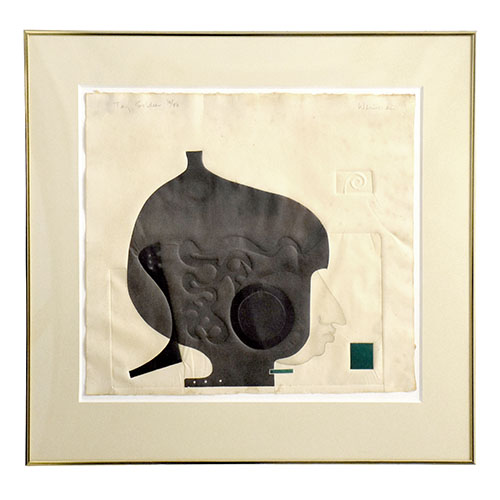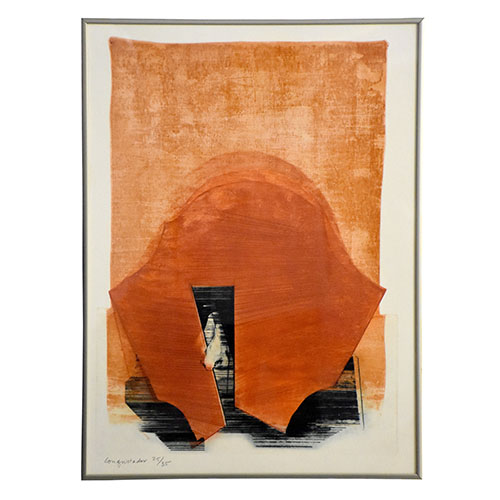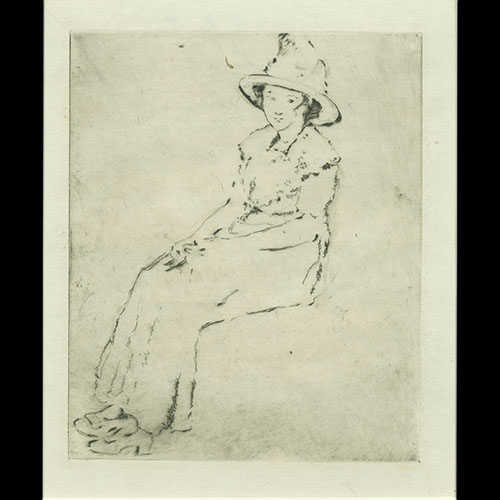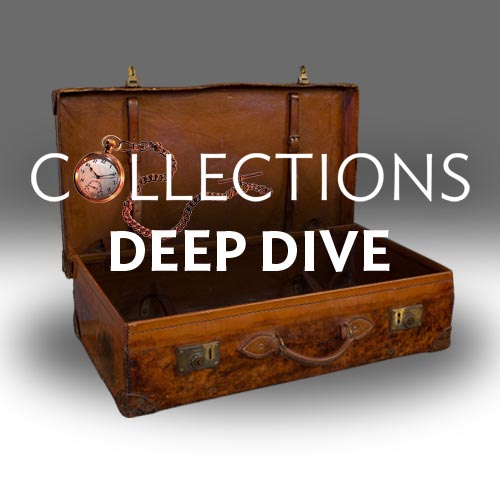Printmaking is one of the oldest art forms. It has many different techniques that ultimately have the same outcome; a transfer of an image using positive and negative space. There are four main areas of printmaking with each having their own effect and technique. They include intaglio, lithography, relief printing and serigraphy (silk screening). There are a few examples of printmaking techniques in the museum’s collection including drypoint etchings and intaglio and relief prints.
Intaglio
Intaglio printmaking refers to prints being made from recessed space filled with ink to transfer the image. Intaglio typically uses metal plates such as copper, zinc, or aluminum but some artists have used plexiglass and other materials. Intaglio has multiple branches of styles and techniques to create an image. They include engraving, drypoint, etching, aquatint, and mezzotint.
Engraving is one of the earliest forms of intaglio printmaking and uses a special tool called a burin to create direct lines onto a copper plate. A burin has a diamond shape point and is used by pushing into the plate to create linear lines. The plates are typically turned to create curved lines and crosshatch lines create shadows and tonal changes. The engraving process is difficult and requires patience and practice.
Drypoint Printmaking
Drypoint printmaking is more fluid and allows more freedom for the artist to draw. Drypoint etching uses a scribe tool or a sharp needle to draw the image into the plate. The tool creates a “burr” in the plate which allows the ink to fall into the ridge. The burr depth is determined by the artist by how deep it is penetrated into the plate. The deeper the burr, the more ink will seep into it creating a bold and darker effect when printed. Drypoint printing uses a thick ink that needs to be spread over the surface with either a knife to scrape into the burrs or a roller to distribute evenly. Once the ink is on the plate, the artist then needs to wipe off the surface which will leave the ink in the burrs. The artist will use a tarlatan cloth (similar to cheesecloth) to wipe off the ink in areas not drawn. The wiping technique is usually gentle enough to remove ink from the bare plate areas but leaves it in the burrs. Once the plate is finished, the artist will use damp paper that is bigger than the plate to print the image. The printing press has double rollers and presses two thick felt cloths that cover the paper when rolling. The plate shape is usually embossed into the damp paper leaving an outline. Some ink that was not wiped off on the positive areas will give an effect called plate tone.
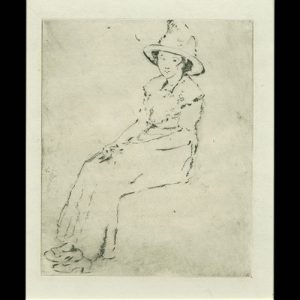 An example of a drypoint print can be seen in this piece created by artist David Milne titled “Patsy in Profile”. Milne used a consistent line depth to create the main outline. He then used a deeper burr to create shadow and depth in areas of the hat and dress. The wiping technique shows some plate tone residue, and the plate imprint is visible in the paper.
An example of a drypoint print can be seen in this piece created by artist David Milne titled “Patsy in Profile”. Milne used a consistent line depth to create the main outline. He then used a deeper burr to create shadow and depth in areas of the hat and dress. The wiping technique shows some plate tone residue, and the plate imprint is visible in the paper.
This print was made while Milne was living in New York between 1909 and 1911.
Etching
Etching uses the same technique as drypoint but uses acid baths to deepen the bite of the burr. The acid penetrates the burrs creating deeper ridges where more ink can be held. Acid baths also allow for tonal changes and darker lines where more metal was eaten by the acid. For etching, the artist will need to cover the plate in an acid-resistant material called an etching ground. The ground protects the entire plate and only the areas drawn with the etching needle would be exposed. The longer the plate sits in the acid, the deeper the line and darker it will appear when printed. The artist can then put the plate in the bath multiple times to create a tonal change in the lines that are previously drawn and the newer layers. Depending on the image, the artist may want certain areas darker and will draw that first knowing it will be exposed the most to the acid. If the artist wants a softer line, they will draw those details near the end so the lines are not exposed in the acid for a long period creating a smaller burr. The same printing process is used in etching with wiping the plate, using wet or dampened paper, and using the double roller printing press.
Aquatint
Aquatint uses the same concept from etching but can be considered its own medium with its complexity and variations. It is often compared to watercolour painting from the effect it gives and its more painterly application. Aquatint has a process that involves using a powder to coat the plate that allows for tonal changes. The rosin powder is applied to the plate through a dusting process. As the powder settles it coats the plate evenly. The plate is then heated which melts the powder onto the plate. This coating forms small droplets which consists of miniscule dots. These dotted areas are what is exposed to the acid bath and where the ink will adhere to. The artist will use a product called asphaltum or stop-out which acts as a barrier to the acid. The areas that are blocked out will resist the acid and will be left white when printed. Areas of the plate can be submerged into the bath for various time lengths which deepens the bite. Alternatively, the artist can paint on the acid with a brush then rinse off with water at desired lengths of time. The artist can use a magnifying glass to inspect the plate and see the depths and grit the acid has created. This helps prevent the risk of over exposure. The artist has flexibility to redraw with the stop-out in various areas to create the desired image. The plates are rinsed in water and use the same printing process of rolling the ink on the surface, wiping off access and running the plate through a printing press.
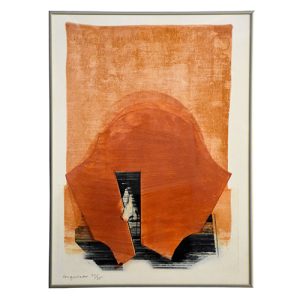 An example of the etching process can be seen in Alan Weinstein’s intaglio prints. The artist uses several techniques to achieve the variations of tonal changes. For instance, the print titled “Conquistador” shows how the acid bath would be timed longer to achieve the dark depths in the black areas. In the area of the nose, there are some lighter shadows that could have had a block out to resist the deeper burr. It appears to have aquatint on the rust colour section where there are darker and lighter areas in one background. Since aquatint gives a watercolour effect, the acid could have been applied with a brush to give the multi-dimensional and speckled appearance. Overall, the various plate sizes and placement can be seen in the print where Weinstein carefully lined up sections to create the multi-layer image.
An example of the etching process can be seen in Alan Weinstein’s intaglio prints. The artist uses several techniques to achieve the variations of tonal changes. For instance, the print titled “Conquistador” shows how the acid bath would be timed longer to achieve the dark depths in the black areas. In the area of the nose, there are some lighter shadows that could have had a block out to resist the deeper burr. It appears to have aquatint on the rust colour section where there are darker and lighter areas in one background. Since aquatint gives a watercolour effect, the acid could have been applied with a brush to give the multi-dimensional and speckled appearance. Overall, the various plate sizes and placement can be seen in the print where Weinstein carefully lined up sections to create the multi-layer image.
Mezzotint
Mezzotint can be considered one of the more tedious and challenging printmaking styles. It uses the opposite effect by contrasting dark to light. The dark areas are created first often in a single tone. The artist uses a tool called a “rocker” which ultimately does rock back and forth to create the burrs. The rocking is often done in multiple directions to create the areas for the ink to sink into. The artist uses other tools such as burnishers and scrapers to push down the burrs created by the rocker. The flat areas retain less ink and in turn creates a velvety and painterly quality to the print.
Relief Printmaking
Relief printmaking uses the opposite technique where the non-recessed areas get the ink and the reverse image is printed on paper. Relief printmaking uses blocks (or sometimes plates) usually made of wood or linoleum. Since wood grain can show up during printing, linoleum blocks have a more solid appearance. The artist use gouges or chisels to carve into the block strategically creating the image. The artist can use the same block to build an image simply by washing the ink off the surface and re-carving more details. Some artists have used multiple blocks simultaneously to create one printed image. The ink is typically rolled on the block to create an even consistency and remains on the surface. An etching press can be used for relief prints, or the artist can print by hand by taking a hard surface and rubbing the paper into the block.
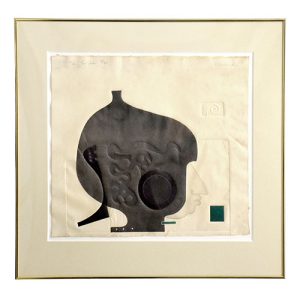 Artist Alan Weinstein also used the relief printmaking technique in his body of work. An example of a relief print can be seen in “Toy Soldier”. The impressions left in the paper would have been created by using a block with the carved design. The artist appears to have used the blocks without ink and leaves the impressions in the white areas of the paper, or in the previously printed image of the face. These impressions would have had to be placed strategically on the press bed and the paper damp enough to hold the carved impression. When the paper dried it likely created a tighter and more defined line.
Artist Alan Weinstein also used the relief printmaking technique in his body of work. An example of a relief print can be seen in “Toy Soldier”. The impressions left in the paper would have been created by using a block with the carved design. The artist appears to have used the blocks without ink and leaves the impressions in the white areas of the paper, or in the previously printed image of the face. These impressions would have had to be placed strategically on the press bed and the paper damp enough to hold the carved impression. When the paper dried it likely created a tighter and more defined line.
Printmaking 101
For consistency in all types of printmaking, an artist will create a template with margins that allow the paper to be placed in the correct location every time it runs through the press. These templates can be drawn on a clear sheet of mylar that marks where the plate or block is placed. The paper can also be marked to line up with the template. The type of paper will also need to be considered for the type of printing. In most cases the paper is wet from either being soaked in a water bath or dampened/sprayed. Choosing the right fibre and thickness is important since the paper will be manipulated and handled frequently.
In most of the printmaking techniques the number of prints taken from a plate is called an edition. The edition can vary in number depending on the artist’s decision. When each print is created, the artist will sign the edition using a series of numbers. Example, if the artist decides to create only 10 prints of an image, they will sign them 1/10, 2/10, 3/10, etc. In general, the edition is signed on the bottom left corner, the title of the work in the centre and the artist’s signature at the bottom right corner. Typically, the information is handwritten by the artist in pencil. In printmaking, there is an Artist Proof (labelled as A/P) and a Studio Proof (S/P). Sometimes the artist will gift the studio proof if the prints were created in another artist’s studio or another printmaking shop. There are fewer studio prints created sometimes making them more valuable to collectors. The artist proof is usually kept by the artist for their own portfolio since other prints are typically sold. There are also Limited Edition Prints and Open Prints. Limited Edition Prints means there will only be a certain number of prints pulled from one plate and never to be printed again. Open prints means there is no limit to how many prints can be pulled from the plate and can be repeated as needed.
Unlike other forms of printmaking, a monoprint is when the print is only created once. A monoprint allows the artist to become freer with their mark making and experimentation. Sometimes an artist will free hand paint or add in a collage to a print. They can also use their wiping technique differently to select certain areas to express their marks. The spontaneity of the process is its appeal.
A centuries old artistic medium, printmaking is still in use by modern artists in their artistic practice who continue to experiment with its possibilities.
Sources:
https://thevirtualinstructor.com/reliefprinting.html
https://www.simplyjackvettriano.com/blogs/depository/what-is-a-studio-proof
https://www.jacksonsart.com/blog/2021/07/06/everything-you-need-to-know-about-printmaking-paper/
https://www.artandobject.com/news/printmaking-techniques-you-should-know
https://www.youtube.com/watch?v=E8RR9GREalY – Aquatint process
Accession A2021.022.
Weinstein, Alan. “Conquistador” [etching]. 1971. A2021.022.004, Bruce County Museum & Cultural Centre.
Weinstein, Alan. “Toy Soldier” [relief print]. 1979. A2021.022.008, Bruce County Museum & Cultural Centre.
Milne, David. “Patsy in Profile” [etching]. 1909-1911. A956.073.005. Bruce County Museum & Cultural Centre.

